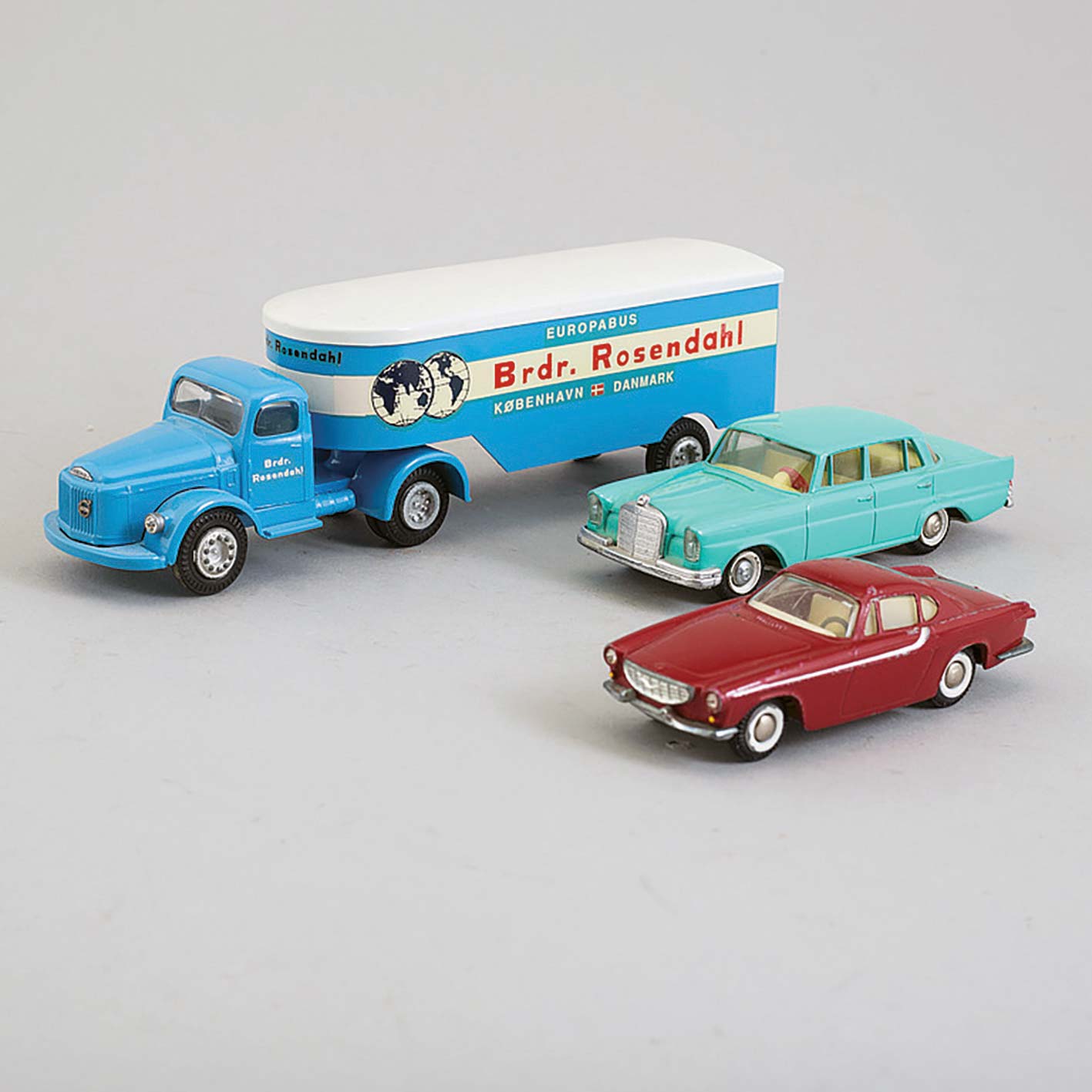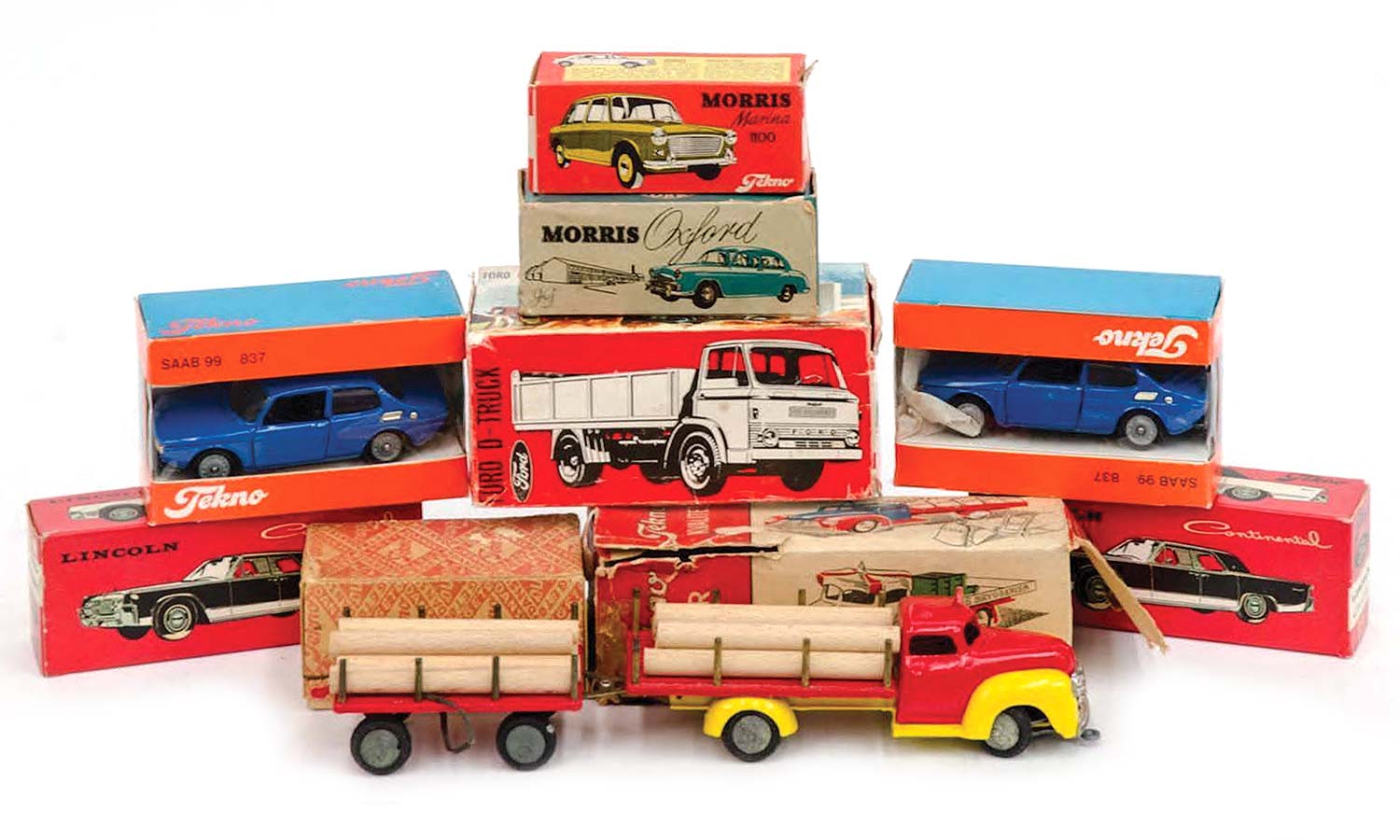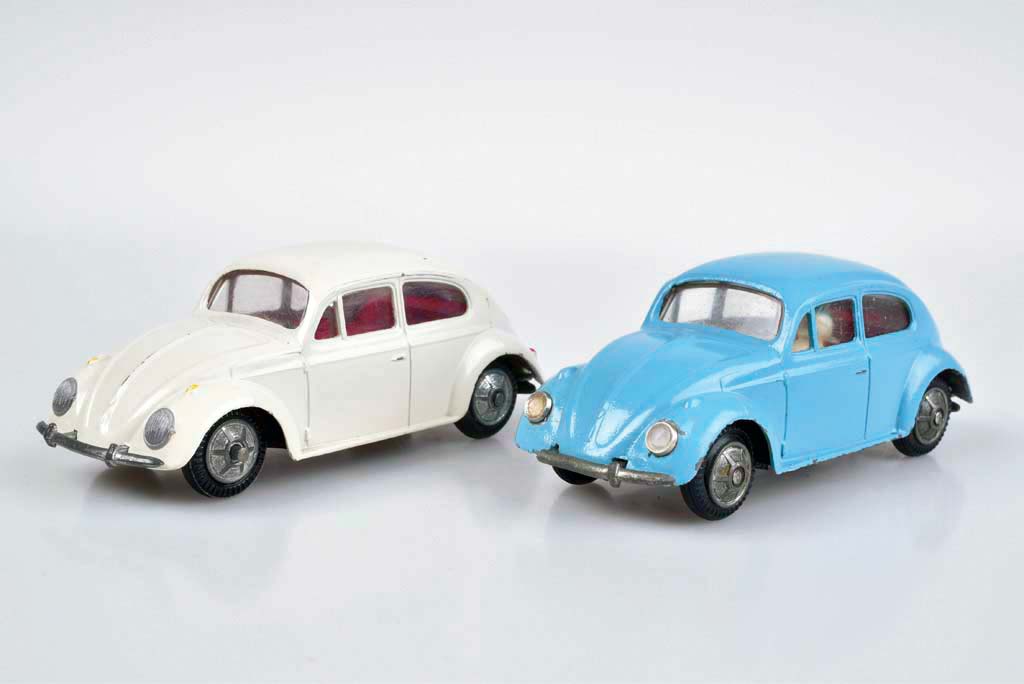

Tekno was created in 1935 as a brand name of Dansk Legetojs Industri (Danish Toy Industry). The latter was founded in 1928 by Danish plumber Andreas Siegumfeldt, who began by making toys in his basement in the Vanløse district of Copenhagen. Under the Tekno name, the company started to produce tinplate cars, fire tenders and other model vehicles, with 60 employees working at the factory by 1938. When Tekno was confronted with the wartime tinplate ban in 1940, the maker nimbly switched to the manufacture of wooden toys.
Tekno commenced production of its celebrated diecast models in the postwar period. The lingering tin shortage (and the scarcity of other metals) after the war led Tekno to turn to a zinc-based alloy for diecast manufacture. The alloy, called Zamac, was made up of zinc, aluminium, magnesium and copper (Zamac being an acronym for those metals). At the time there were few with the necessary expertise and experience in the manufacture of zinc moulded cars and the manufacturer and his staff of employees had to produce the necessary moulds, tools and machinery required for such a production. These early diecast toys included a number of Dodge and Ford trucks, emergency vehicles and aircraft.
Tekno grew and formed a partnership with another Danish toymaker, H Lange, in 1948-49. The company created its export division, Tekno Svenska AB, in 1950. With this expansion in its business, Tekno began shipping its models to Holland, Germany, the UK and the US. As the company completely wound down its production of tinplate toys in the mid-1950s, export of its diecast toys flourished. Tekno’s models of Volkswagen vans in various liveries proved especially popular, with more than two million Beetles being produced in 1959 – many more than were manufactured of the actual vehicle itself.
Toymaker Kirk Production bought H Lange in 1960 and the success of Tekno’s model autos continued to grow. The 1960s was the golden age of diecast toys and models, with British makers such as Corgi, Dinky and Matchbox famous the world over. Tekno’s sales peaked at over one million models per year during this decade. Approximately two-thirds of these sales were made up of exports.
Tekno founder Andreas Siegumfeldt died in 1969 and the models started to be made under the Kirk brand name in 1970. That year and in 1971, tug-of-war acquisitions of Tekno by Kirk and Algrema financially undermined the company, leading to Algrema-Tekno becoming insolvent in 1972. After this economic fallout, Vanmin BV, a Dutch importer of Tekno goods, bought the Danish company.

By 1974 this purchase created Tekno Toys BV (Besloten Vennootschap, or ‘private limited liability company’). The new Dutch-owned Tekno was based in Delft, the Netherlands. Dutch Tekno moved further into the manufacture of detailed scale models designed for adults. In order to highlight the fact that their products were intended for collectors, the company dropped the word ‘toys’ from its name in 1989.
Today, Tekno is owned by the Van Buuren company and is headquartered in Maasland. In order to differentiate it from the original Danish Tekno, it is sometimes referred to as ‘Tekno Holland’.
Danish Tekno was known for its 1:43rd and 1:50th scale models of Scandinavian vehicles. These included representations of the Volvo Viking truck in many guises. Tekno produced a multitude of these as tankers, auto transporters, low loaders, dairy trucks, moving vans, timber carriers, tippers and more.
Tekno also created models of the Volvo Express truck in both articulated and standard forms. These ranged from fire tenders to refrigerated trucks to dropsides and fresh-produce trucks. Tekno also manufactured models of the Volvo F88 and F89 transport trucks, plus various Volvo buses.
Swedish vehicle maker Scania-Vabis was also represented by many Tekno models, which ran the gamut from Scandinavian-style cement trucks to covered dropside transport lorries and a large array of tankers. Tekno also made models of the Scania CR-76 bus, some of which had labels advertising BP or Jolly Cola.
Founder Andreas Siegumfeldt one day looked in the shop window of a toy store and was so annoyed by the poor quality he saw, he decided to go into production himself … in 1930, just two years after its launch, the Tekno collection of tin toys was sent to be rated by the Industry Council, where it received the highest possible manufacturing award.
Miniatures of vehicles of Scandinavian automakers were also important in the line-up of Tekno’s model cars. These included the Saab 93 and 96; the Volvo PV544, Amazon, Amazon station wagon, the P1800 (the type of car Roger Moore drove in The Saint), the 144 and 164. German, Italian, British and American automakers were also represented by Tekno’s models of cars by NSU, Alfa Romeo, Austin, Mercedes-Benz, Opel, MG, Ford, Jaguar and others. For even more variety, Tekno offered models of several classic Vespa scooters, some with sidecars, as well as Indian and Harley Davidson motorcycles.
Not forgetting aviation buffs, the Danish company made several airliner models, such as a Caravelle in Swissair or SAS livery, the DC-7C propeller airliner, plus jet fighters including the F-100 Super Sabre. There were also models of many other aircraft, such as WWII bombers and fighters.
Amongst Tekno’s other creations were a range of 1:87th scale plastic cars, dollhouse furniture, figures and games. Additionally, the company produced building sets akin to those of Erector and Meccano. Marketed as Ingeniørsæt, or ‘Engineering Set’, they featured green flatiron pieces, orange pulleys and wheels, and brass nuts and bolts. Some sets came with electric motors and batteries to provide power to various creations which could be constructed from the set’s components.
Danish Tekno models are much sought after by collectors of classic diecast. These Tekno pieces, especially those in mint condition with original boxes, can command high values from bidders through such houses as Vectis Auctions Ltd in England. For an idea of the current health of the Danish Tekno market, let’s have a look at results from some recent online auctions (prices in Australian dollars).
It can be a serious business (and an investment) collecting these Danish jewels. Some begin their collections of Tekno models with lower-valued examples which don’t have their original packaging and/or are in less than mint condition. Others buy models in poor condition and restore them.
Creating a collection of original Tekno models is a way to commemorate and preserve Danish workmanship. A collection such as this also honours periods of classic motoring, and the golden age of diecast toys when Tekno was a major Danish exporter, with its models famed and beloved amongst children and adults around the world.